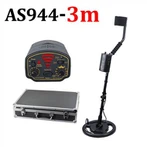Pointer multimeter resistance working principle
Pointer multimeter the simplest measurement principle shown in Figure 1. Measurement of resistance switch SA to "Ω" gear, the use of internal batteries as a power supply, by the external resistance to be measured, E, RP, R1 and the head part of the closed circuit, the formation of the current deflects the pointer of the head. Let the resistance under test be RX, the total resistance in the meter be R, and the current formed be I, then:
From the above equation, it can be seen that I and RX are not linearly related, so the scale of the resistance scale on the dial is not uniform. Resistance gear scale scale is reverse indexing, that is, RX = 0, the pointer points to the full scale; RX → ∞, the pointer points to the mechanical zero point of the meter head. Resistance scale scale from right to left indicates a gradual increase in the measured resistance, which is just the opposite of other instrumentation instructions, which should be noted in the reading.
Resistance gear to measure the resistance of the operating procedures:
1, mechanical zero: will be placed according to the way the multimeter (MF47-type is placed horizontally) placed (a put); to see whether the multimeter pointer is pointing at the left end of the zero scale (see); if the pointer does not point to the left end of the zero scale on the use of a screwdriver to adjust the mechanical zero screw, so that it points to zero (three adjustments).
2, the initial test (test test): the multimeter switch to ohm × 100 gear. Red and black pens were connected to the two pins of the measured resistance, measurement. Observe the indication position of the pointer.
3,Choose the appropriate multiplier: according to the position of the pointer to select the appropriate multiplier.
(1) The selection criteria for the appropriate multiplier: so that the pointer indicates near the median value. It is best not to use the left one-third of the scale, this part of the scale is dense, the reading deviation is large. I.e., the pointer should try to point between the numbers 5-50 on the ohm-rating scale.
(2) Quickly select the appropriate multiplier selection method: the number of large, the multiplier increases; the number of small, the multiplier decreases.
Note: the number of signals is large or small is relative to the scale on the number of 5 - 50 interval. In the pointer on the right side of the 5 is known as the number of small; pointer on the left side of the 50 is known as the number of large.
4, ohm zero: multiplier selected after the ohm zero, the two pens shorted, turn the zero ohm adjustment knob, so that the pointer on the resistance scale to the right of the "0" Ω at.
5, measurements and readings: the red and black pens were contact with the two ends of the resistance, read out the size of the resistance value.
Reading method: the head of the pointer indicated by the number of indications multiplied by the selected multiplier value that is the resistance value of the measured resistance. For example, the choice of R × 100 gear measurement, the pointer indicates 40, the measured resistance value is: 40 × 100 = 4000Ω = 4KΩ.






